Archives
Ode to The Lone Drainer and Pronto
There once was a drain that was blocked, and its contents left me quite shocked.
But fear not my friend, we have tools to amend, our Rattlesnake will leave your drains clear.
With a flick of the wrist and a twist, the Rattlesnake is in the abyss,
As it wriggles and writhes, and the blockage soon dies, leaving your drains as clean as if kissed.
So if you’re in a fix, with a drain that plays tricks, don’t hesitate, cause it’s a NO Brainer,
With our service online, we’ll have your drains cleaned on time, Three cheers for Sydney’s Lone Drainer.

How to Stop Snakes in a drain!
On a recent trip to balmy Townsville, North Queensland our Saturday night movie screening on a friends verandah was interrupted when another guest saw a three metre python moving on the roof next door. Said serpent was moving towards the open windows of the neighbours first floor bedroom! Our hostess declared intermission, paused the movie and contacted the neighbours to close their bedroom windows.
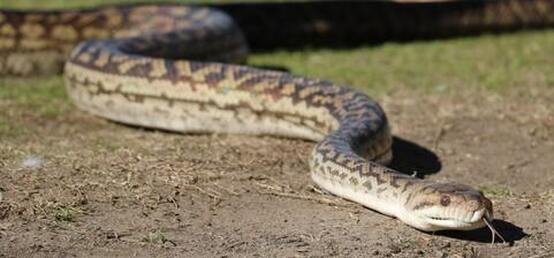
The other movie-goers, Queenslanders, shrugged, took a sip of their XXXX and declared “Thats Townsville!”
This cowboy immediately found it difficult to focus on the french sub-titles and only think about how I could prevent pythons from getting in my North Queensland friends storm water pipes.
By the time the movie had ended I came up with a few simple ways to prevent pythons from entering your North Queensland storm water pipes:
- Install wire mesh or grates: Fit wire mesh or grates over the openings of your storm water pipes. Use a mesh with small openings to prevent snakes from slithering through. Make sure the mesh or grates are securely fastened to prevent any gaps.
- Seal pipe joints and cracks: Inspect your storm water pipes for any gaps, cracks, or loose joints. Snakes can squeeze through surprisingly small openings, so seal these gaps using appropriate materials like silicone sealant or concrete patching compound.
- Regularly maintain and clear vegetation: Remove any overgrown vegetation or debris around your property, particularly near the storm water pipes. Pythons are attracted to areas with ample hiding spots, so keeping the area clear reduces their habitat and discourages them from approaching.
- Consider snake repellents: Some commercially available snake repellents emit odors that snakes find unpleasant. Consult with a local expert or snake control professional to determine if such repellents are effective and suitable for your situation.
- Monitor and remove potential snake magnets: Snakes are often attracted to food sources, like small animals or rats and mice. Take steps to control rodent populations around your property, such as securing garbage bins and removing potential food sources.
- Educate yourself and your neighbours: Learn about the types of snakes in your area, their habits, and their preferred habitats. Share this knowledge with others in your community to raise awareness and promote snake-safe practices.
- Consult a local snake expert: Reach out to local wildlife or snake experts who have experience dealing with snakes in your specific region. They can provide valuable advice and guidance tailored to your location.
Remember, it’s important to handle snakes with caution and avoid direct confrontation. If you encounter a snake or suspect an infestation, contact the local wildlife authorities or snake control professionals for assistance and advice.
Use Toilet Paper NOT Tissues
We are regularly asked to clear blocked toilets and drains that are often caused by products that are Not meant to flush down our toilets that drain to our sewer pipes.
This 1:17min YouTube clip gives a very simple demonstration on why you should only use toilet paper.
Sanitary Napkins, Tampons, Condoms, Baby Wipes, Flushable Wipes, Cotton Buds? The answer is NO!
We recommend and supply Who Gives a Crap if you need Toilet Paper.

Because we do! 🙂
If you have a blocked drain, I know a guy!
The Lone Drainer and Pronto. The Gondolier and the Oar maker
I woke this morning May 29th 2023 to read the Sydney Morning Herald story from Venice about the Grand Canal turning a distinctive green. A colour familiar to me.
It looks like the fluorosceine dye we emergency plumbers use to identify the source of water and sewage leaks. It’s often been used by school kids young and old for end of year pranks to turn a fountain green. I believe it is harmless to small aquatic organisms.
I immediately sent a text message to Gio my Venetian gondolier mate to say G’day. It’s a few years ago now that we had Gio guide us around his home town of Venice. Aaah. Travel and plumbing! Spend six minutes with Gio as he shows me around the workshop of Paolo Brandolisio his oarmaker.
On June 1st 2023 a similiar green dye appeared in Melbourne’s Yarra river.
Follow this link to see the story on Australian ABC.
Click here to see other blog posts about Venice courtesy of Gio
Do tree roots grow in sewer pipes during winter?
As we transition into another Sydney winter, my thirst for knowledge about trees and their roots and how and why they grow in sewer pipes and whether they are as active as during the warmer months led me to here.
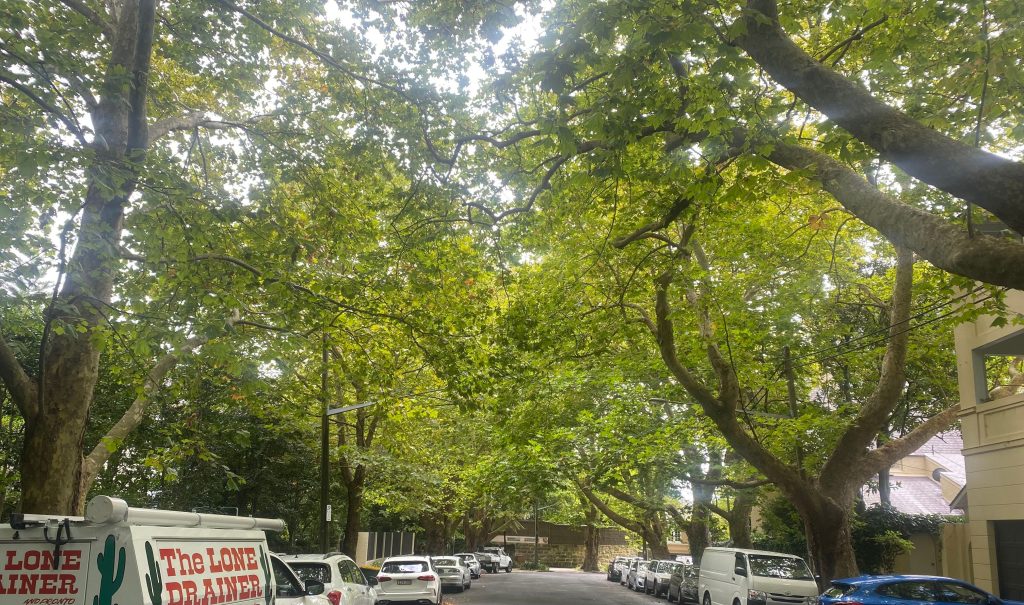
This magnificent display of London Plane trees in Woollahra was just starting to move into autumn mode and we were called to a blocked drain in the street. The blocked drain was caused by tree roots.
Tree roots generally grow more slowly or become dormant during the winter months. The growth of tree roots in drains is influenced by several factors, including temperature, soil conditions, and moisture availability. In colder climates, where winters are harsh and the ground freezes, root growth is typically limited or even halted.
During winter, the soil temperature drops, making it less favorable for root growth. Additionally, the availability of water is often reduced due to freezing or low precipitation levels. These conditions make it difficult for roots to actively grow and expand. Our seasons are changing but traditionally winter in Sydney is our dry season.
However, it’s important to note that tree roots can still function and absorb some nutrients from sewer pipes and drains during winter and continue to cause blockages albeit at a slower rate. They continue to provide support and anchorage for the tree, even if growth is minimal. I believe they are preparing for the spring while they’re hibernating.
And that’s why we still have to attend to tree root drain blockages during winter.
Root growth typically resumes in the spring when temperatures rise, and the soil becomes more conducive to growth. As the weather warms and soil conditions improve, tree roots become more active, allowing for increased growth and development.
Now if you live north of the NSW and Queensland border this theory would probably be tested because it doesn’t cool down as much as the southern states.
If you live in Australia’s sunny north and have a tale to tell about your blocked drains and tree roots, you can tell it here.
Full Moon Blocked Drains
Regardless of the season, tree roots block drains.
And there is a school of thought they occur more during the full moon :-).
However, there is no scientific evidence to suggest that tree roots are more likely to cause blocked drains during the full moon.
The idea that the full moon affects tree roots and causes them to grow more or become more active is a myth that has been around for a long time.
Blocked drains can be caused by a variety of factors, including tree roots about 85% of the time.
Tree roots grow in response to a variety of factors, such as moisture, nutrients, and changes in temperature, but the phase of the moon has no effect on this process.
Tree leaves and other debris, especially from our deciduous trees can accumulate in pipes, as well as grease, oil, and other substances like paint and even cement sometimes gets poured down the drain.
Regular maintenance and cleaning can help prevent blocked drains and keep your pipes flowing smoothly.
The full moon on the east coast of Australia is at about 14.30 today April 6th, 2023.
Are you buying a house on a tree lined street? Six things to consider!
If you have your eye on a house in a tree lined street, you should read this!
While street trees can have many benefits, there are also some potential negative impacts that should be considered.
- Damage to the street infrastructure: Street trees can cause damage to footpaths, roads, and buildings if their roots grow too close to or under them. They can also damage underground utilities such as electrical cables, water and gas pipes. The tree root systems will also cause blocked drains and sewer pipes. If you get a blocked drain you should call The Lone Drainer and Pronto.
- Maintenance: Street trees require regular maintenance, such as pruning and watering, to ensure they remain healthy and safe. This can be a significant cost for utility companies, municipalities and homeowners. Radical pruning is used to shape the street trees away from overhead electric power and communication lines.
- Allergies: Some people may have an allergic reaction to certain species of street trees, such as those that produce a lot of pollen.
- Invasive species: Some species of street trees can become invasive, meaning they can spread rapidly and compete with the native species. This can have a negative impact on local ecosystems and biodiversity.
- Canopy closure: Street trees can cause a canopy closure, blocking the sunlight and view, making the street darker and less attractive in the winter months. However, in our hot summer, the shade they provide brings a welcome relief from the heat of the day.
- Your car: Parking your car under a tree like this Hill’s Weeping Fig Ficus microcarpa hillii during certain seasons can be very messy. The fig has berries….. Lots of them. They attract possums, flying foxes and birds that feast on the berries and subsequently make a BIG mess on your car.
It’s important to consider these potential negative impacts when selecting, planting, and maintaining street trees. Proper tree selection, planning, and management can help to minimize these negative impacts and maximize the benefits of street trees.
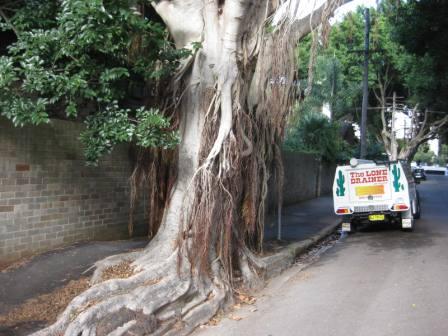
How to fix a blocked drain caused by tree roots.
If you have tree roots in your sewer pipes, you should watch this 1:56 minute YouTube Clip
Tree roots will lift, crack and maybe even crush those pipes, resulting in some very expensive replacement costs to dig up and renew the broken pipes.
Plumbers call pipe or drain blockages “chokes” … If your sewer pipes are choked, then call us on (02) 9664 4990
This clip shows how we use the latest plumbing technology to clear out your blocked drains.
In the first part of this demonstration in a clear plastic pipe, you’ll see how high pressure water drain cleaners work inside your pipes.
85% of blocked drains are caused by tree roots and this clip shows how the different drain cleaning heads move through the pipes and subsequently the tree root blockage, cutting and mulching the tree roots and blowing them back through the pipeline.
Tree roots grow in through the top of the earthenware pipe joints and depending on where the tree is, root blockages can be in more than one pipe joint.
A drain camera or Drainoscopy used in conjunction with the high pressure water will help your plumber cut out all the tree root blockages at the pipe joints.
Once we cut the tree roots from your sewer pipes, we can then apply Vaporooter to prevent regrowth of tree roots in your pipes.
The Vaporooter process is cost effective, and comes with a 12 month GUARANTEE!
If you would like to find out more, please call us on 02 9664 4990
What happens when tree roots grow in sewer pipes #2
The growth of tree roots in sewer pipes is probably the most destructive single element that faces those maintaining a sewer collection system today. 
Sewers are ageing expensive assets that only attract public attention when they fail. There are over 35,000 kms of water and sewer pipes in Sydney and 60% of all collection systems are made up of pipes with a diameter of 9 inches (225 mm) or smaller. The potential for tree root intrusion to inhibit flows, produce blocked drains and damage valuable pipes, is enormous.
Tree roots normally do not grow underwater and seldom cause problems where ground water covers the pipe. But in most areas, this is not the case.
Tree Roots Grow One Cell at a Time
When a seed germinates, it adds one cell at a time toward the best environment from which it might extract nutrients and moisture. The growing point of a tree moves best through loosely cultivated soil.
The most common practice used to lay sewer pipes is in an open trench. The back-filled soil offers a good growing medium for tree roots. Because the flow in sewer pipes is a higher temperature than the soil, this causes a condensation to appear on the crown of the pipe.
As the warm moisture from the sewer pipe evaporates up through the soil, the vapours offer an excellent trail for the tree roots to follow. If a vapour leak exists in the pipe, the roots concentrate its efforts at that point. Since some pipe joint compounds are of nutrient based material themselves (like rubber rings or sand cement mix), the root may entirely girdle before entering the pipe.
Roots Allow Accumulation of Debris
Once inside the sewer pipe, the root takes on the appearance of a “veil” or “horse tail” type structure. If flows in the pipes are fairly constant, the root mass hangs down like a veil to the normal flow level where they accumulate deposits of grease, slime and other debris.
Conventional methods of removing tree roots by cutting with an electric eel or a “Rattlesnake” high pressure water drain cleaner tend to increase regrowth; similar to pruning a tree. Removing tree roots inside the pipe solves the immediate problem of clearing the blocked drain, but does nothing to retard the tree root regrowth or destroy the tree roots outside the pipe.
This removal, regrowth and removal cycle of cutting and tearing roots can destroy the structural integrity of the pipe.
Herbicide Fumigants
Herbicide fumigants present the most effective method to destroy tree roots and inhibit their regrowth without affecting the above ground plant life. Vaporooter is a root control herbicide that enters the sewer as a foam. Only tree roots within the pipe and a short distance outside the pipe are affected. Trees and shrubs immediately above ground are not harmed in any way.
Tree roots never sleep
Coogee 2034 Sydney, Australia
G’day Sydney
We’re back at work in January 2022!
Our workload didn’t really let up over the Christmas and New Year period because tree roots just keep growing in pipes.
If you are having the same problem with roots in your drains and you are looking for a short-term or long-term solution call me on 1800 637 600
Or check out our site VaporooterAustralia.com.au
There may be a cost-effective solution there for you!
Stop Tree Roots in PVC pipes
Bellevue Hill, Sydney, Australia
This post is a simple one. The house shown here is quite new!
The sewer pipes are also new PVC. But, where the house sewer line joins into the Sydney Water sewer main there are roots from a large Fig tree on the footpath out the front growing into the sewer connection.
We are putting Vaporooter into the pipes to stop tree root regrowth at that single point.
It’s a simple process and I hope you have seen it before.
You can see our equipment on the rock shelf behind and also see the Vaporooter foam coming up through the cap in the footpath.
Even new houses with PVC pipes can get tree roots growing into them.
There is a simple way to Stop tree roots in Drains. It’s Vaporooter!
If you need to find out more about it, Ask me.
Call 1800 637 600
Contact The Lone Drainer and Pronto 02 9664 4990
Or check out VaporooterAustralia.com.au
Raw sewer overflows to Coogee Beach.
During the Stay at Home orders we’ve been doing emergency plumbing repairs like hot water, leaking pipes and Blocked drains.
The blocked drain that got my interest is the one taking the waste from 28 houses on Raleigh Street and Carrington Road, Coogee.
The filthy waste water has been bubbling up through the ground about 50 metres down the hill from the houses and running across the footpath in front of other homes not connected to the service, into the street gutters that drain into the creek at the north end of Coogee beach for most of July.
Apparently the 28 home owners are unaffected by the blockage because it’s not in their backyard and a Sydney Morning Herald article reports Sydney Water and Randwick City council cannot force the home owners to pay for any repairs.
It’s well known that every home owner is responsible for the maintenance of their waste water pipes up to where they join the Sydney Water sewer main out in Carrington Road.
This pipeline is known as a common sewer and the costs for any maintenance should be shared equally between all those home owners connected to it.
Come on Randwick Council, Stop this river of sewage running down to Coogee Beach!
Get a contractor to fix the problem and split the costs among the 28 property and home owners.
Click here to read our earlier post on Common Sewer lines.
Is it O.K. to take a longer shower?
As Sydney and most of New South Wales is knee-deep in floodwater I had a friend ask me this morning, “is it OK to take a longer shower?”
I encouraged him and his entire family to take a longer shower over the next few days. Using the water may actually help those that are living downstream from Warragamba Dam where the residents and farmers are flooded by the water running over the dam spillway and overwhelming the Nepean and Hawkesbury river systems downstream.
Just over twelve months ago we were in the grip of a drought that was choking our country cousins and dust storms were commonplace across New South Wales.
The rain won’t last forever, in fact, it’s forecast to clear up this afternoon and deliver a 29° hot sunny day tomorrow.
The rain has exposed many blocked drains and stormwater pits and pipes. So when the sun comes out, make the most of the abundant water in our catchment dams and clean out those pits, grates, drains and the rainwater down pipes blocked with leaf debris.
World Plumbing Day 2021
Today is the 11th of March 2021 and it’s World Plumbing Day!
I just wanted to remind you that twelve months ago today, which was also World Plumbing Day, that we had a pandemic declared in Australia. While we’ve all had our lives changed over the last twelve months, the trees that you can see around me here are still growing in the drains in this house.
We have come back for our annual application of Vaporooter to STOP tree roots growing in the sewer pipes of this beautiful home.
Enjoy World Plumbing Day. Thank your local plumber, enjoy his company. Make him a cup of tea or coffee.

Woollahra Council trees are blocking my drains
Many of the blocked drains we attend to are caused by the trees that line the streets managed by Woollahra Council.
At street level, the trees’ canopy brings summer shade and all kinds of birdlife.
Contrary to belief, tree roots don’t go in search of water. They are stimulated as moisture levels, and the surrounding soil temperature reaches a point that is appealing to them.
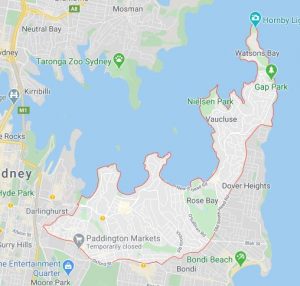
Sydney suburbs managed by Woollahra Council: Bellevue Hill, Darling Point, Double Bay, Edgecliff, Paddington, Point Piper, Rose Bay, Vaucluse
In most circumstances, the tree roots enter through leaking pipe joints and damage the sewer drains and stormwater pipes that take wastewater off your property. Many homeowners hold Woollahra Council responsible for their blockage and expect they will clear their blocked drains for free because the Council own the trees.
Well, in some cases they do!
But, Woollahra Council gets their income from you the ratepayer, and as you would expect, they have guidelines for spending ratepayers money to fix your blocked drains.
If you live in one of the suburbs managed by Woollahra Council, click here to see the Woollahra Council Wastewater Policy.
The top points are that you the homeowner:
Must have a sewer service diagram for your home.
Must maintain your sewer pipes.
Must prevent sewer blockages.
Must prevent sewerage from escaping into the environment.
May be entitled to the Council plumber clearing your blocked drain.
Waverley Council trees are blocking my drains
Did you know 85% of blocked drains are caused by tree roots?
In Waverley Council’s jurisdiction, blocked drains are cause quite often by the roots of the trees that line the streets.

They can block drains and sometimes damage the sewer and stormwater pipes that take wastewater off your property.
Many homeowners hold Waverley Council responsible for their blockage and expect they will clear their blocked drains for free because they own the trees.
Well in some cases they do!
But, Waverley Council gets their income from you the ratepayer and as you would expect, they have guidelines for spending ratepayers money to fix your blocked drains.
If you have a Blocked drain and live in one of these suburbs managed by Waverley Council including Bondi, Bondi Beach, Bondi Junction, Bronte, Charing Cross, Clovelly, Dover Heights, North Bondi, Queens Park and Waverley, click here to see the Waverley Council Sewerage Stormwater Drain Blockage Policy.
The top points are that you the homeowner:
Must have a sewer service diagram for your building.
Must maintain your sewer pipes.
Must prevent sewer blockages.
Must prevent sewerage from escaping into the environment.
May be entitled to the Council plumber clearing your blocked drain.
Randwick Council trees are blocking my drains
Blocked drains are a large part of our workday; every day! And 85% of blocked drains are caused by tree roots. Our home is Coogee Randwick, in the eastern suburbs of Sydney Australia.

Tree-lined streets in Randwick Council are the reason for a lot of the blocked drains that we attend to. They damage the sewer drains and stormwater pipes that take wastewater off your property.
Many homeowners hold the council responsible for their blockage and have expectations that the council will clear their blocked drains for free because they own the trees.
Well in some cases they do.
But, Randwick Council gets their income from you the ratepayer and as you’d expect they have guidelines for spending ratepayers money to fix your blocked drains.
If you live in one of these Sydney suburbs managed by Randwick Council including Centennial Park, Chifley, Coogee, Kensington, Kingsford, Little Bay, Malabar, Maroubra, Matraville, Pagewood, Phillip Bay, Port Botany and Randwick, click here to see Randwick Council Sewerage Stormwater Drain Blockage Policy.
The top points are that you the homeowner:
- Must have a sewer service diagram for your home
- Must maintain your sewer pipes.
- Must prevent sewer blockages
- Must prevent sewerage from escaping into the environment
- Maybe entitled to the Council plumber clearing your blocked drain
Flushable wipes block drains
As you know, up to 85% of blocked drains are caused by tree roots and can be easily managed.
But, there is a growing number of blocked drains that are caused by “hygienic wipes”. Hygienic wipes block up house drains and sewer mains that cost homeowners and Sydney Water a fortune to maintain. So be careful what you flush!
To put it simply, hygienic wipes don’t break down like toilet paper and as many household pipelines have imperfections, the wipes get caught and cause a blocked drain.
If you are polishing your bottom….. and flushing more wipes, you could be in trouble.
This Choice magazine YouTube video shows how wipes don’t break down for up to 21 hours.
Don’t do this in the bathroom!
During our Coronavirus work schedule, I’ve found some fun hints and tips about plumbing and health that are worth sharing.
How germs spread:
- on your toothbrush,
- your toilet seat,
- and the toilet flush button, are just a few examples.
Cow gets stuck in sewer manhole
During a long career dealing with blocked drains we have seen some unusual things in the sewer, and this is one of them.
This 1:53sec YouTube clip shows a team of Chinese firefighters, police and vets rescue a cow that has fallen down a sewer maintenance hole.
The pregnant cow looks pretty uncomfortable as she is winched out of the manhole. But she ambles off into the night with her grateful owner as if nothing has happened.
Toilet paper is no longer a hot ticket. Guess what is?
The stampede on toilet paper has slowed for now. But I overheard an 18 year old chemist assistant telling her mum about the latest hot items running out the door of her pharmacy during the lockdown over the last 4 weeks that is worth sharing.
She rattled off a list of items and her thoughts on why.
With respect to brand names…
Armaforce – General health.
Panadol – Just in case they get the virus.
Thermometers – 36.3 is normal body temperature.
Lemsip – To keep colds away.
Betadine – I don’t know why.
Voltaren – Over training by the work from home crew.
Thrush cream – They’re all wearing leggings and have thrush. Bad idea.
Pregnancy test kits – There will be a baby boom early 2021.
Nail polish – They can’t go anywhere.
Why you need a sewer diagram
One of the handiest tools for a plumbing professional is a sewer service diagram. It’s a map of where the sewer pipes run within your home.
It’s easily obtainable, and you can get it from Sydney Water, reputable plumbing suppliers and, even your local plumber can get it for you.
It’s simply an A4 sheet that has an outline of your home, your property. It shows where all the pipes run within your home and how they connect to the sewer.
The sewer service diagram will make it easier for your plumber to get into your sewer pipes to clear your blocked drain. And if you are planning a preventative maintenance program, it shows points of access where we can get into your pipes with a minimum of fuss.
In the long term it will save you money.
So if you have repeat problems with your sewer pipes, get a sewer diagram and keep it handy.
Tree roots don’t know about Coronavirus
Sydney April 14th 2020
Easter is over for another year.
Although our towns are slowing because of the Coronavirus, and we are quickly changing our daily home and work habits, here at The Lone Drainer and Pronto, we are still working away.
Working from home is putting our normal facilities under a little more pressure. That means the internet, the exercise areas and our bathrooms.
With all that extra baking and comfort meals, our sewers are under a more significant workload. Tree roots don’t know about Coronavirus, and still seek food and water in the sewer pipes they can grow into.
So, if you hear your drains gurgling don’t ignore them. They are asking for help.
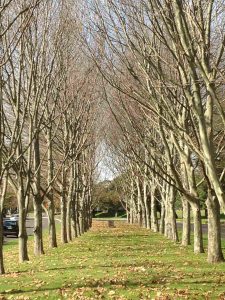
Dormant, but active underground
Be careful what you flush down the toilet!
Sydney March 31st 2020
As we work through COVID-19, our work, social distancing, hygiene and consumption habits are being challenged daily.
The run on toilet paper in our supermarkets has left me bewildered.
I had to see it for my own eyes. And did!
The take away for me is that those who couldn’t purchase their normal supply have resorted to buying and using baby wipes, paper towels and facial tissues. Please remember they’re not for flushing down the toilet because they don’t break down and can block your drains!
If you’re desperate for toilet paper we have a few boxes at our Coogee office.
Why have a Drainoscopy?
Today our post is simple.
A client from Bronte called. Since Christmas they’d had 3 blocked drains causing the downstairs toilet to overflow. Yuck!
The plumber they had been using didn’t have a drain camera and it was suggested that the pipes were broken.
We were able to clear the blockage quickly, then, give the pipes a Drainoscopy. That’s Lone Drainer speak for “put a specialised drain camera in the pipes and see what is really going on.”
The pipe was full of tree roots. That’s all!
We cut out the roots and had another look.
A simple Vaporooter treatment will keep the roots away. With a Guarantee!
Yes, the pipes are old clay pipes. You can see where the roots have been cut out. But, they work and will for some time to come.
The best way to find out is to see it for yourself.
